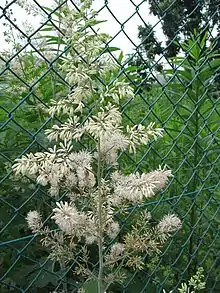Macleaya cordata
Macleaya cordata, the five-seeded plume-poppy,[1] is a species of flowering plant in the poppy family Papaveraceae,[2] which is used ornamentally.[3] It is native to China and Japan. It is a large herbaceous perennial growing to 2.5 m (8 ft) tall by 1 m (3 ft) or more wide, with olive green leaves and airy panicles of buff-white flowers in summer.[4]
| Macleaya cordata | |
|---|---|
 | |
| Scientific classification | |
| Kingdom: | Plantae |
| Clade: | Tracheophytes |
| Clade: | Angiosperms |
| Clade: | Eudicots |
| Order: | Ranunculales |
| Family: | Papaveraceae |
| Genus: | Macleaya |
| Species: | M. cordata |
| Binomial name | |
| Macleaya cordata | |
| Synonyms | |
|
Bocconia cordata Willd. | |
Etymology

The Latin cordata means "heart-shaped", referring to the leaves.[5] The common name plume poppy is used for plants of the genus Macleaya.
The Chinese name 博落回 (bóluòhúi) is derived from 簸邏迴 (bòluóhúi), the Xianbei name for a musical instrument also known as 大角 (dà jiǎo, "big horn"), because the sound of blowing the dried[note 1] hollow stem resembles the instrument sound.[6]
The Japanese name 竹似草 (takenigusa) means "bamboo-like herb", also referring to its hollow stem.
Cultivation
It self-seeds readily and can be invasive, so in cultivation requires space. It is a popular subject for flower arranging. It has gained the Royal Horticultural Society's Award of Garden Merit.[7]
Macleaya × kewensis, bred at Kew Gardens, is a hybrid of M. cordata and M. microcarpa. The cultivar 'Flamingo' has pink tinged flowers, and has also received the Award of Garden Merit.[8]
Other uses
Macleaya cordata is a source of a variety of chemical compounds, mainly isoquinoline alkaloids. The seed oil contains dihydrosanguinarine, dihydrochelerythrine, and twelve fatty acids of which linoleic, oleic, palmitic and stearic acids predominate.[9]
Footnotes
- The sap is very poisonous, so the fresh stem should never be blown.
References
- "BSBI List 2007". Botanical Society of Britain and Ireland. Archived from the original (xls) on 2015-01-25. Retrieved 2014-10-17.
- "Macleaya cordata - (Willd.)R.Br". Plants for a Future (PFAF).
- Pink, A. (2004). Gardening for the Million. Project Gutenberg Literary Archive Foundation.
- RHS A-Z encyclopedia of garden plants. United Kingdom: Dorling Kindersley. 2008. p. 1136. ISBN 978-1405332965.
- Harrison, Lorraine (2012). RHS Latin for gardeners. United Kingdom: Mitchell Beazley. p. 224. ISBN 9781845337315.
- 陳藏器 (739). 本草拾遺 (in Chinese).
- "Macleaya cordata". www.rhs.org. Royal Horticultural Society. Retrieved 1 October 2020.
- "RHS Plant Selector - Macleaya × kewensis 'Flamingo'". Retrieved 26 June 2013.
- Kosina, P.; Gregorova, J.; Gruz, J.; Vacek, J.; Kolar, M.; Vogel, M.; Roos, W.; Naumann, K.; Simanek, V.; Ulrichova, J. (2010). "Phytochemical and antimicrobial characterization of Macleaya cordata herb". Fitoterapia. 81 (8): 1006–1012. doi:10.1016/j.fitote.2010.06.020. PMID 20600683.
External links
| Wikimedia Commons has media related to Macleaya cordata. |
- "Macleaya cordata" (in French). nature.jardin.free.fr.